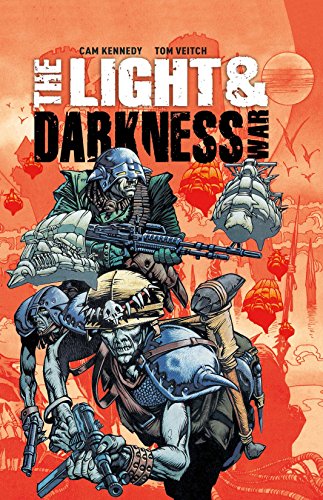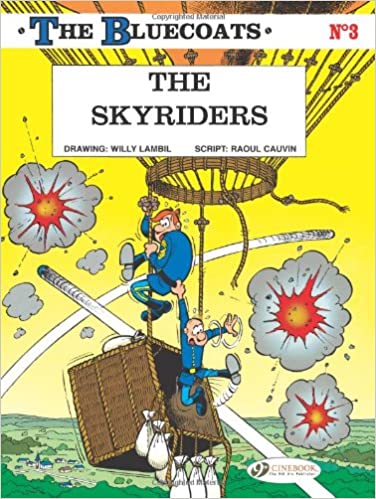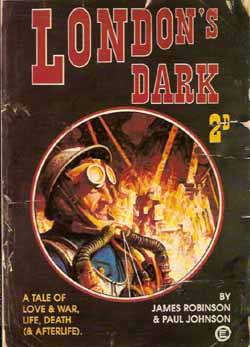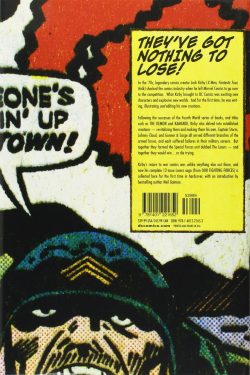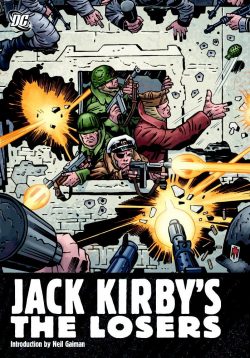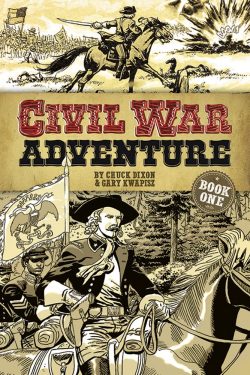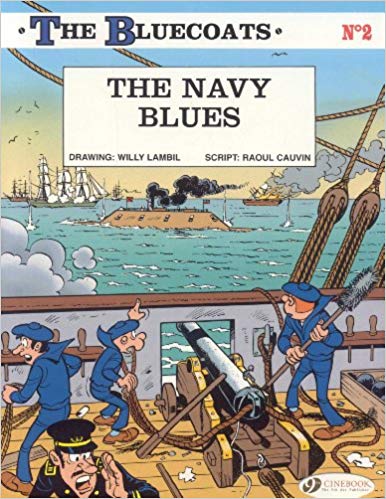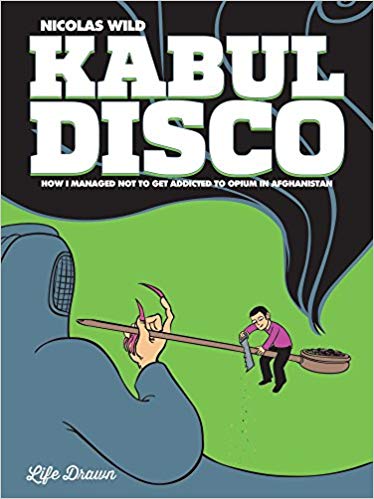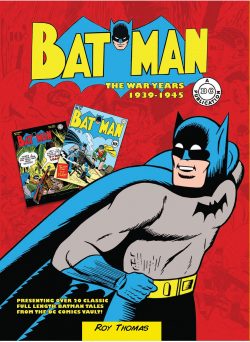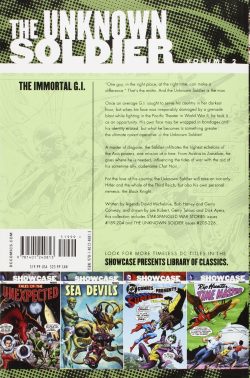

By David Michelinie, Bob Haney, Robert Kanigher, Gerry Conway, Gerry Talaoc, Dick Ayers, Joe Kubert, Romeo Tanghal & various (DC Comics)
ISBN: 978-1-4012-4081-3 (TPB)
Whereas the Britain comics scene has never relinquished its fascination with war stories, in America after the demise of EC Comics in the mid-1950’s and prior to the game-changing Blazing Combat, the only certain place to find controversial, challenging and entertaining American combat comics was DC.
In fact, even whilst Archie Goodwin’s stunning but tragically mis-marketed quartet of classics were waking up a small section of the current generation, the home of Superman, Batman and Wonder Woman was a veritable cornucopia of gritty, intriguing and beautifully illustrated battle tales exploring combat on a variety of fronts and from many differing points of view.
Whilst the Vietnam War escalated, 1960s America increasingly endured a Home Front death-struggle pitting deeply-ingrained Establishment social attitudes against a youth-oriented generation with a radical new sensibility. In response, DC’s (or rather National Periodical Publishing, as it then was) military-themed comicbooks became even more bold and innovative…
That stellar and challenging creative period came to an end as all strip trends do, but a few of the more impressive and popular features (Sgt. Rock, Haunted Tank, The Losers) survived well into the second superhero revival. One of the most engaging wartime wonders was a compelling espionage thriller starring a faceless, nameless hero perpetually in the right place at the right time, ready, willing and so very able to turn the tide one battle at a time…
This second moody monochrome paperback compendium (still criminally unavailable in digital formats, as are far too many non- superhero, horror or sci fi tales) collects the lead feature from issues #189-204 of the truly venerable Star-Spangled War Stories anthology mag (July 1975-March 1977) and thereafter #205-226 (May 1977-April 1979) of the abruptly re-titled Unknown Soldier from when the “Immortal G.I.†finally took over the book in name as well as fact.
One of the very best concepts ever devised for a war comic, The Unknown Soldier was actually a spin-off – having first appeared as a walk-on in a Sgt. Rock yarn from Our Army at War #168 (June 1966, by Robert Kanigher & Joe Kubert).
By 1970, the top flight illustrator had become group editor of DC’s war titles and was looking for a new cover/lead character to follow the critically acclaimed Enemy Ace who had been summarily bounced to the back of the book after issue #150.
The new series featured a faceless super-spy and master-of-disguise whose forebears had proudly fought and died in every American conflict since the birth of the nation…
As previously stated, the strip grew to be one of DC’s most popular and long-lived. With issue #205 in 1977, Star-Spangled became Unknown Soldier and the comic only folded in 1982 (issue #268) when sales of traditional comicbooks were in harsh decline.
Since then the character has resurfaced a number of times (12 issue miniseries in 1988-9, a 4-part Vertigo tale in 1997 followed by a rebooted ongoing series in 2008, and again in 2011 as part of the company’s “New 52†mega reboot): each iteration moving further and further way from the originating concept.
One intriguing factor of the initial tales is that there is very little internal chronology: for most of the run individual adventures take place anytime and anywhere between the bombing of Pearl Harbor and the surrenders of Germany and Japan. This picaresque approach adds a powerful sense of both timelessness and infallible, unflinching continuity. The Unknown Soldier has always and will always be where he is needed most…
As seen in the previous Showcase volume, his full origin was revealed in Star-Spangled War Stories #154’s ‘I’ll Never Die!’: recounting how two inseparable brothers enlisted in the days before America was attacked and were posted together to the Philippines just as the Japanese began their seemingly unstoppable Pacific Campaign.
Overwhelmed by a tidal wave of enemy soldiers one night, the brothers held their jungle posts to the last. When relief came only one had survived, his face a tattered mess of raw flesh and bone…
As US forces retreated from the islands the indomitable survivor was evacuated to a state-side hospital. Refusing medals, honours or retirement, the recuperating warrior dedicated his remaining years to his lost brother Harry and determinedly retrained as a one man-army intelligence unit.
His unsalvageable face swathed in bandages, the nameless fighter learned the arts of make-up, disguise and mimicry, perfected a broad arsenal of fighting skills before offering himself to the State Department as an expendable resource who could go anywhere and do anything…
After a long run of spectacular stories by numerous stellar creators, shifting fashions eventually provoked a shift in emphasis. Relative neophytes David Michelinie & Gerry Talaoc came aboard with Star-Spangled War Stories #183, resulting in an evocative change of direction.
The horror boom in comics was at its peak in 1974 and new editor Joe Orlando capitalised on that fascination with a few startling modifications – the most controversial being to reveal the Soldier’s grotesque, scar-ravaged face – presumably to draw in monster-hungry fear fans…
Here the military/macabre mood resumes with Michelinie & Talaoc on fine form and well dug-in as the Unknown Soldier is despatched to discover the secret of the ‘The Cadaver Gap Massacres’ (SSWS #189).
What he finds as Nazi officer Major Wollheim is a death camp where prisoners are guinea pigs for making monsters and experimental atrocity weapons. Before long he falls foul of a repentant, guilt-riddled scientist whose loyalties ultimately are only to money. The ghastly discoveries of ‘Project: Omega’ lead to a cataclysmic clash with uncontrollable beast-men and the salvation of the only true innocent in the capacious modern hellscape…
Issue #191 offered ‘Decision at Volstadt’ as the fleeing superspy encounters rabid resistance fighters, merciless Hitler Youth zealots and fanatical Lt. Strada, who has already lost far too much to the Immortal G.I. Captured by his Italian nemesis, the rival soldiers’ ‘Vendetta’ ends the only way it could in SSWS #192…
Gerry Conway scripted ‘Save the Children!’ in #193, detailing how a mission to blow up a train carrying generals directing the war on the Eastern Front goes horribly wrong after the phantom fighter finds his targets’ families have come along for the ride, after which Michelinie returns to investigate ‘The Survival Syndrome’ wherein penetration of a high-tech Nazi communications complex hidden in a French village shows the wary warrior the true cost of a having a quisling in the family…
Star-Spangled War Stories #195 introduced ‘The Deathmasters’ as the Unknown Soldier infiltrates a Nazi assassination school and find himself assigned to murder one of the Allies’ greatest assets in war-torn Odessa in #196’s ‘Target Red’.
Conning everyone into thinking he’s succeeded, the Soldier then returns to Germany to scotch a scheme to replace key Allied personnel with Nazi doppelgangers. All it costs to quash the project is the life of an innocent girl and a little bit more of his soul…
The war in North Africa is almost over in #197 but the master of disguise is nevertheless dispatched to destroy German anti-tank airplane prototypes in ‘The Henschel Gambit’. Typically however, he is intercepted by Arab raiders led by a US Senator’s maverick daughter and is again forced to choose between his mission and innocent lives…
Thereafter, thanks to Nazi counter-intelligence manoeuvrings, the Immortal G.I. is tricked into killing the Allies’ top strategist in ‘Traitor!’ Court Martialled and sentenced to death, he is forced to escape and retrace his steps, seeking a witness to his innocence in #199’s ‘The Crime of Sgt. Schepke’.
En route, he encounters Maquis legend Mlle Marie but events spiral completely out of control and has no choice but to sacrifice her entire resistance unit to destroy a new super-weapon in the concluding ‘Deathride’ Although Marie honours her promise and clears his name, she also swears to kill him for expending her comrades like pawns…
The scene switches to New York City in SSWS #201 as the Soldier engages in ‘The Back-Alley War’: infiltrating a gang of German-American anti-war isolationists in search of saboteurs and spies.
He’s in Italy for #202 where an outbreak of typhus is holding up the war. His task is to find a downed US plane carrying an experimental counter serum but his infiltration of a Nazi hospital seems to indicate that neither side has found ‘The Cure’…
Issue #203 sees the master-spy reduced to teaching arrogant, unstable English aristocrat (with royal connections) Richard Ebbington all the tricks of his deadly craft, only to be subsequently ordered by the top brass to stop his unstable pupil from fulfilling his first murder mission.
Somebody up top forgot to tell somebody in the middle that Ebbington’s target is a German general planning to assassinate Hitler, so the Unknown Soldier is forced to stop his protégé’s ‘Curtain Call’…
After 36 years of gloriously variegated publication, Star-Spangled War Stories ended with #204 as prior scripter Bob Haney and veteran war artist Dick Ayers joined Talaoc for ‘The Unknown Soldier Must Die!’, wherein old ally Chat Noir(an African-American sergeant who got fed up of institutionalised racism and deserted the US Army to join the French Resistance) is captured by the Nazis and brainwashed into becoming their secret weapon against the Immortal G.I.…
Cover-dated May 1977 the first Unknown Soldier (#205) places history’s lynchpin at the Battle of the Bulge in winter 1944. Whilst expanding on his origins ‘Legends Never Die!’ also proves once more that the right man in the right place at the right time can change the course of destiny…
‘Glory Gambit!’ begins an extended campaign as Adolf Hitler himself unleashes the Wehrmacht’s answer to the Unknown Soldier. His Black Knight is Count Klaus von Stauffen: the chess-obsessed SS officer who captured and brainwashed Chat Noir. The fascist fanatic is now making his way into the heart of England with but one mission…
The hunt for the merciless master of disguise and doom continues throughout London in #207’s ‘Kill the King!’, before the scene again shifts, dumping the Soldier in North Africa in 1942 to rehabilitate a trio of deserters in ‘Coward, Take my Hand!’
US #209 takes us to the Pacific in 1945 and a personal duel with a Japanese prison camp torturer whose attempts to break the scarred superspy result in defeat, death and ‘Tattered Glory!’ on blood-drenched rock called Iwo Jima…
In #210 the Man of Many Faces invades a Nazi fortress by impersonating a specialist interrogator. He has been ordered to rescue or kill America’s most important agent in ‘Sparrows Can’t Sing!’, after which issue #211 reprints a classic Haney & Kubert tale from Star-Spangled War Stories #159 wherein George S. Patton became the thinly-veiled basis for ‘Man of War’ with the Unknown Soldier dispatched to investigate a charismatic general who had pushed his own troops to the brink of mutiny…
An experimental surgical operation traps the G.I. behind the wrong face on the wrong side of the German lines in #212, where he encounters Hitler’s fanatical schoolboy “Werewolf†killer-elite and becomes in turn ‘The Traitor in Wolf’s Clothing!’
The shocking theme was further explored in #213 as Unknown Soldier has to extract from the Fatherland the son of a scientist vital to the war effort. Sadly, ‘The Ten-Year-Old Secret Weapon!’ has embraced every facet of life in the Hitler Youth and fights his would-be rescuer every step of the way…
Kanigher wrote and Romeo Tanghal inked the Ayers illustrated ‘Deadly Reunion!’ in #214 as of the Soldier – in the guise of an elderly Jew – allows himself to be taken to a death camp to spring Mlle. Marie. She isn’t at all grateful…
Haney, Ayers &Talaoc reunite in #215 as the faceless fury replaces a sailor in the merchant marine to expose a traitor selling out convoy freighters to U-boats haunting ‘The Savage Sea!’, after which ‘Taps at Arlington!’ (art by Ayers & Tanghal) sees Chat Noir confront American racism whilst the Soldier exposes a spy painting a bullseye on the backs of troops in Italy…
In #217 the Man Without a Face becomes Hermann Goering’s chief supplier of stolen paintings in ‘Dictators Never Sleep!’ The plan is to give the infamous art lover a Rembrandt primed to explode when Hitler is in front of it… and it would have worked if Klaus von Stauffen hadn’t been present…
With the Black Knight hot on his heels, the frustrated phantom is harried across Europe in ‘The Unknown Soldier Must Die!’, only stopping briefly to destroy a V2 base and have another shot at the Fuehrer before experiencing ‘Slaughter in Hell!’ (inked by Tanghal) when von Stauffen turns the tables by impersonating his arch enemy in a bid to murder Winston Churchill and General Dwight D. Eisenhower.
He would have succeeded if not for the Immortal G.I.’s strategic cunning…
Issue #220 by Haney, Ayers &Talaoc sees the Soldier organise a band of maverick warriors from many Nazi-conquered countries into a daring-but-doomed foreign legion dubbed ‘The Rubber Band Heroes’, after which ‘Sunset for a Samurai!’finds him on a suicide mission to the heart of Japan to save an undercover agent crucial to the American forces…
Unknown Soldier #222 promised ‘No Exit from Stalag 19!’ when the unsung hero is ordered to rescue a military boffin from the heart of Fortress Europa (in a wry and trenchant riff on The Bridge on the River Kwai) whilst in #223, ‘Mission: Incredible!’ (Ayers &Tanghal) details the convoluted course of a plan to destroy a Heavy Water plant in the snow-capped mountains of Norway.
The Soldier and Chat Noir reunite in #224 to investigate a dead zone where Allied bombers vanish without trace, only to find barbaric military madness running wild in ‘Welcome to Valhalla!’ after which the Immortal G.I. is forced to arrest a charismatic general for treason in ‘Four Stars to Armageddon!’ (Ayers & Talaoc) before uncovering the astounding truth behind his supposed betrayals.
The military madness lurches to a bloody halt with #226 as Chat Noir and his faceless comrade do what entire flotillas of Navy vessels could not: using guile and subterfuge to board the Nazi’s unbeatable dreadnaught and ‘Sink the Kronhorst!’…
Dark, powerful, moving and overwhelmingly ingenious, The Unknown Soldier is a magnificent addition to the ranks of extraordinary mortal warriors in an industry far too heavy with implausible and incredible heroes. These tales will appeal to not just comics readers but all fans of adventure fiction.
© 1975-1979, 2014 DC Comics. All rights reserved.
